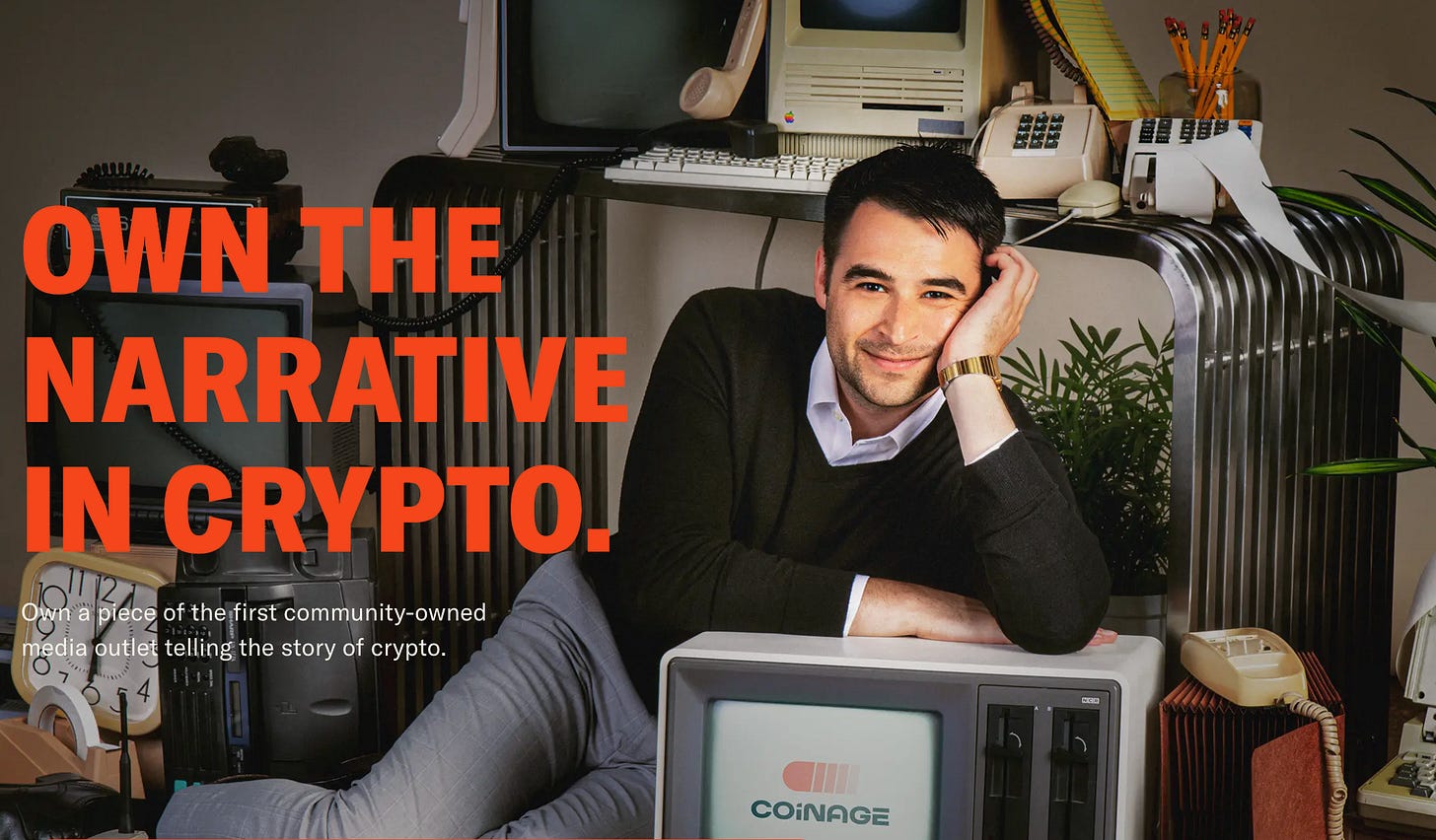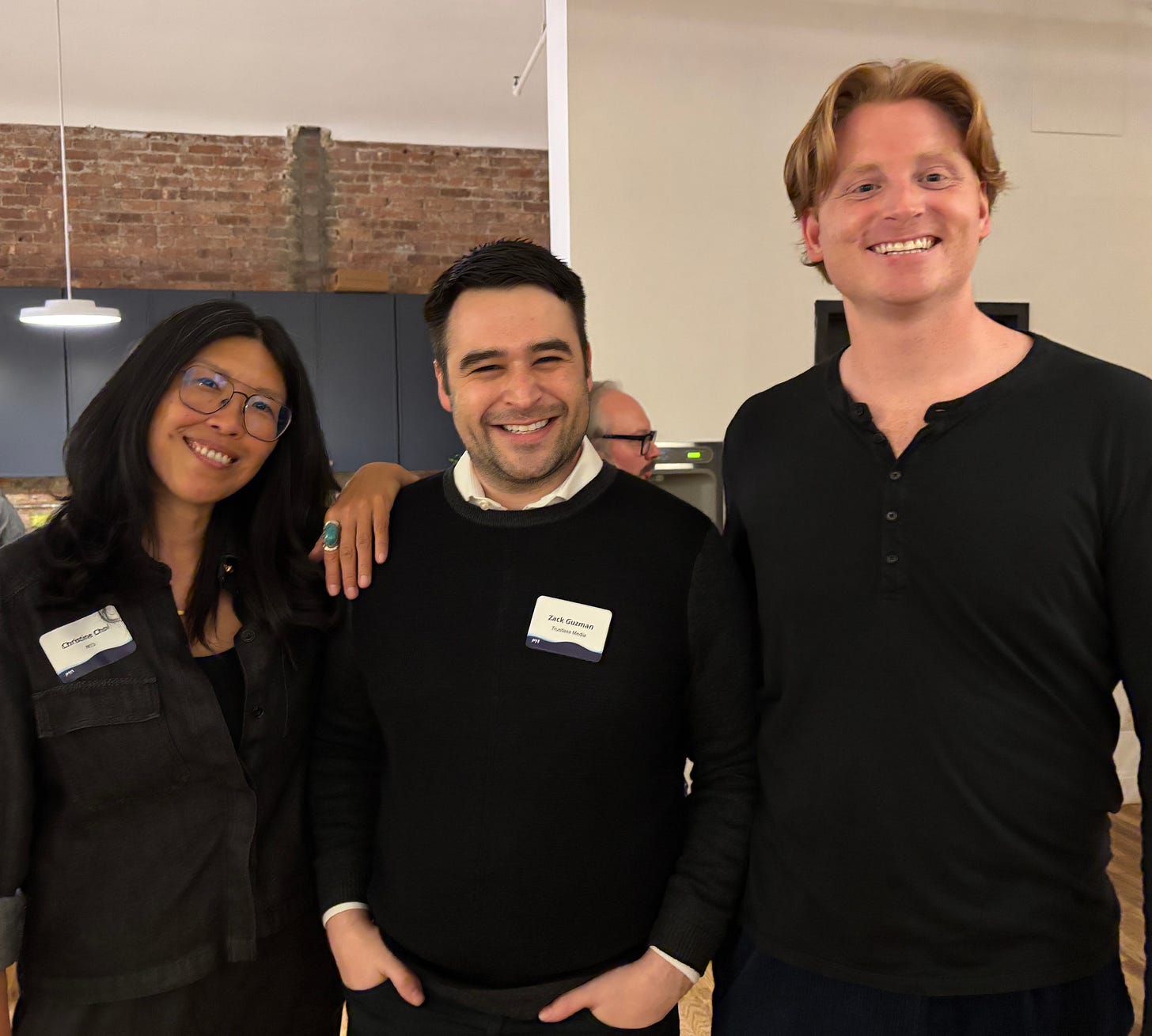Dispatch from new media: a business model that sounds like a gimmick but might be the future
The way we consume news has put us in this wild bazaar of a media long tail. Independent news creators are rebuilding trust in media through authenticity (Prof G Market’s Ed Elson) and editorial identity (Polina Pompliano and Eric Newcomer). What happens when trust comes not just from the reporter but the underlying tech? This dispatch looks at the work of Zack Guzman who started Trustless Media, a blockchain-based media platform where audiences consume the news and co-own it too.
Zack and I met in 2018 when he was an anchor for Yahoo! Finance Live and covered breaking news, tech and startups. A rising star, he left broadcast news in 2022 to do what sounded crazy at the time: start a community-owned media platform built on blockchain.
Confession: I used to think of NFTs as ugly digital art.
But blockchain and NFTs enable audience co-ownership. Enter ConstitutionDAO.
What turned Zack was a strange and exciting moment in history. Internet strangers formed the ConstitutionDAO to bid on a copy of the US Constitution. More than 17K strangers raised $40M in 72 hours in what may have been the largest crowd fund for a physical object.
Who didn’t root for them?!
Also the memes were soooo good.

In a sign of our late-stage capitalism times, a hedge fund billionaire outbid them. But ConstitutionDAO demonstrated the power of web3 to channel community energy and foreshadowed the cultural movement we’re in today: everyday people dissatisfied with the zero sum, biggest takes all game decide to form a community and take on the establishment, be it Wall Street or big tech or whoever’s in charge.
Zack saw that and more.
Building for a public that’s skeptical and distracted. And invested.
Today’s tech — blockchain — could now let people on the internet form a community and co-own something meaningful. Could it also help rebuild trust in media? How about enabling more coverage of crypto, which mainstream media was reluctant to do because of hype, good and bad actors and not enough expertise to know the difference? He started Trustless Media and within that a news channel with original reporting called Coinage.
Zack’s progress in revenue sharing got me excited about the impact of his business model on the future of media. When Zack took the mic at M13’s new media event, I asked the audience to raise their hands if they thought crypto = grift.
Our audience was too polite to raise their hands but the tittering in the room said enough.
Which made Zack’s story worth telling.
How we know the business model is working.
It’s still early days but this year has been a big one for Coinage. It paid its NFT holders the first distribution, proving the revenue model. It also reached 100K subscribers, earning it YouTube’s Silver Play Button.
Zack is building one of the few media models that’s not only editorially bold but also structurally innovative. By using blockchain as its underlying technology, Coinage turns its audience into active participants while building a transparent and participatory media model.
Here’s Zack in his own words.
On restoring trust in tech with tech.
“What we worked hard on is to build legal frameworks to do something crypto projects couldn't do before, which is build community. This tech could help restore journalism in a way that allows creators not just to make money but trust to be restored online too.”
Media and community are increasingly used in the same sentence — with sincerity. Zack is leaning on transparency and structure to earn – and sustain – trust.
As a journalist turned founder who understands all too well crypto’s credibility problem from the inside out, he’s working to rebuild trust through both storytelling and the underlying technology. He was recently invited to to share learnings about his media model with the SEC’s Crypto Task Force and Commissioner Hester Peirce.
On why crypto matters for media.
“Not only can you now produce content online but you can co-own it with the audience, who has an incentive to share. We’re pulling the curtain back and saying, Look, have a say, take some ownership, both literally and figuratively. You couldn't do this until now. Until NFTs, there was no way to tokenize ownership on the internet. Now we're on the precipice of more real projects.”
Zack looks at NFTs not as speculative assets but as infrastructure for shareholders who are stakeholders. As the first US-based web3 media DAO to distribute profits to its NFT holders, Coinage is proving that crypto-native storytelling can move beyond vibes and into viability with a structure that isn’t just ideological but revenue-generating and legally structured.
On redefining the media-audience relationship.
“We use our NFTs to on-chain let people vote on certain things like stories we cover, guests we should have on the show, directions we should go. When you allow real ownership online, you convert a super fan into a co-owner.”
Coinage recasts the passive subscriber into a stakeholder who understands the industry and shapes its narrative. Offering editorial access to the audience requires guardrails: where does participation end and editorial independence begin?
On what startup founders and indie journalists have in common.
“The best epiphany is this: Creators are the best startup founders in this era of the Internet. No one is better at figuring out why people are watching my content. Allowing people to own that in this era of attention is as important as money in web3.”
Next up, Trustless Media is expanding editorial co-authorship in food with a new platform called Best Dish Ever for NYC eaters to celebrate their favorite local spots. I live to eat and want to participate!
On taking that leap.
“Leaving Yahoo! Finance was weird. It was the dream job. But when ConstitutionDAO happened, I saw the potential of people coming together online to own something. It clicked: that’s the future of media.”
Zack’s personal pivot fits a cultural moment in the promise of the internet a la Chris Dixon’s phrase and book “Read Write Own.” ConstitutionDAO was his case study in collective action: imperfect, unpredictable and proof that people would act for shared ownership.
Why this matters, even for people who roll their eyes when they read “crypto.”
If that’s you, and you’re still reading: thanks! Our new media event was aimed at bringing people who come to media from different sides of the table or screen to exchange fresh perspectives about what it could become. Because they care about news and information. And there’s nothing like an inperson gathering to create spark and spark change for the better.
As I said that night, the boundaries between creator, platform and audience are more porous than ever. In today’s flattened information cycle where traditional gatekeeping has weakened, decisions and outcomes can collapse onto each other. Who tells the story, who decides how it’s made, and who owns the results? What happens when the people building new systems are shaping how we perceive them? Where do “explain” and “inspire” meet, and where do they conflict? And what happens to editorial integrity when media is co-owned?
Where once institutions built to extract, community is building to participate.
Coinage represents for me not only a crypto media platform but a prototype for a participatory business model. And that isn’t just a new kind of newsroom. It’s an acknowledgement of what it takes to earn the public’s frayed trust and where co-ownership reimagines the contract between audience and the media.
Let me know what you think, and see you next time.




Amazing write!